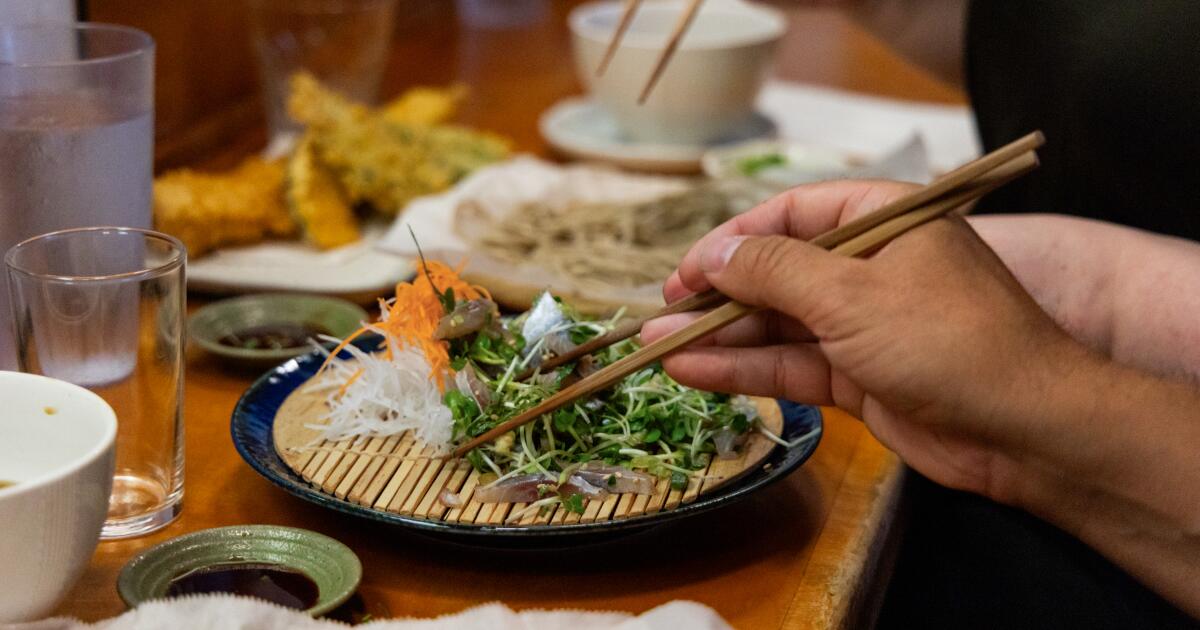On bustling Western Avenue in the heart of Gardena, Sakura-Ya and Chikara Mochi sit about 250 feet away from each other, frequented by South Bay residents for decades for fluffy mochi and cakey manju. They’re two of the only traditional Japanese mochi shops in L.A., with blink-and-you’ll-miss-it signage.
Just a block away is Meiji Tofu Shop, a nearly 50-year-old producer that churns out fresh soy milk and tofu daily. Cross the street to find Otafuku — where the Akutsu family has been serving traditional Tokyo soba since 1997.
You’ll find similar clusters of diverse Japanese food in strip malls across Gardena as well as Torrance, which has the largest East Asian population in all of L.A. The two neighboring cities are home to the biggest suburban Japanese community in the United States — and a decades-old restaurant landscape that feels like a time capsule, yet continues to flourish as a haven for classic Japanese cuisine and hospitality.
“It’s like we’re stuck in the ’90s,” said South Bay native Daniel Son, the chef and owner of Gardena’s Sushi Sonagi. “These days, when everything is monetizing and content creating has to be so fresh, they don’t care. They’re just gonna make great product and quietly do it.”
Japanese immigrants first came to the L.A. area in the late 1800s and early 1900s — many from San Francisco after the 1906 earthquake — as strawberry farmers. Unlike Little Tokyo, which has been subject to the whims of tourists and the changing landscape of downtown L.A., the suburban South Bay has maintained a more stable identity, according to Emily Anderson, a curator for Little Tokyo’s Japanese American National Museum.
“In places like Torrance and Gardena, you have the development and preservation of Japanese American food — it [has] layers of history and struggle, but food ultimately being a source of comfort and identity,” Anderson said.
When Torrance became the site of Toyota’s North American headquarters in 1967, more Japanese immigrants, and food, came with it. Over the next few decades, dozens of restaurants opened in Torrance and Gardena, along with a growing number of Japanese supermarket chains like Tokyo Central, Nijiya Market and Mitsuwa Marketplace, giving neighbors a taste of home.
By the time Toyota left Torrance for Texas in 2017, these businesses had proved themselves integral to the region’s culinary fabric. Their networks, once primarily composed of Japanese immigrants and descendant families, had extended to residents of all backgrounds.
“My plan is to be the last bastion of Japanese food prepared the Japanese way,” said former Tokyo resident Kristen McIntyre, owner of homestyle Japanese restaurant Fukagawa in Gardena.
Many Japanese restaurant owners in the area have a “serve what you want to eat” mindset, said Otafuku owner Mieko Akutsu. “We never adjusted the flavor for American people.”
In her case, that means serving three types of soba, including sarashina soba — a white noodle made using the core of the buckwheat plant — which became known as an upscale dish in Tokyo, where regular, darker soba became a popular working-class meal during the Edo period.
Today, restaurants like Sushi Sonagi, which opened in 2023, along with Michelin-starred Sushi Inaba in Torrance, lead the way in bringing Angelenos — and diners from across the country — to the South Bay, where troves of Japanese restaurants and shops, many immigrant-run and cash-only, shine in all their old-school glory. Many don’t have PR firms or flashy Instagram accounts; some will give you a handwritten receipt and others don’t have websites.
“I felt like [opening Sushi Sonagi] in the South Bay almost celebrates the diversity and the rich Asian American culture that’s very deep here,” said Son, who blends his Korean American heritage into his roughly 20-course omakase. “It’s just really cool to bring more life to an area that I feel like is L.A.’s little secret.”
But sushi is merely the cusp of the region’s offerings. Torrance and Gardena are L.A.’s storied destinations for every type of Japanese food imaginable: Yoshoku restaurants, which combine Japanese and Western cooking, coexist alongside traditional izakayas, yakitori joints and newer businesses that hail from Japan. Use these 18 spots as a starting point for some of the best — and some of the oldest — Japanese restaurants that have quietly put South Bay suburbs on the L.A. dining map.
